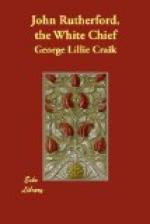Cruise describes a fort at Wangarooa as situated on an insulated rock, about three hundred feet high, and presenting the most imposing appearance. These elevated palings were a subject of much speculation to those on board of Cook’s vessel, when that navigator first approached the coast of New Zealand. Some, he tells us, supposed them to be inclosures for sheep and oxen, while others maintained they were parks of deer.
The New Zealanders may, in some degree, be considered as a warlike people upon the sea. We have no distinct account of any maritime engagements between one tribe and another carried on in their vessels of war; but as these belong to the state, if it may be so termed—that is, as the war canoes are the property of a particular community inhabiting a village or district, as distinguished from the fishing-boats of individuals—it is probable that their hostile encounters may occasionally be carried on upon the element with which a nation of islanders are generally familiar.
Rutherford has given a minute description of a war-canoe, which accords with the representation of such a large vessel in the plates to Cook’s “Voyages":—
“Their canoes are made of the largest sized pine-trees, which generally run from 40 to 50 feet long, and are hollowed out, and lengthened about eight feet at each end, and raised about two feet on each side.
“They are built with a figure head; the stern-post extending about ten feet above the stern of the canoe, which is handsomely carved, as well as the figure-head, and the whole body of the canoe. The sides are ornamented with pearl shell, which is let into the carved work, and above that is a row of feathers. On both sides, fore and aft, they have seats in the inside, so that two men can sit abreast. They pull about fifty paddles on each side, and many of them will carry two hundred people. When paddling, the chief stands up and cheers them with a song, to which they all join in chorus. These canoes roll heavy, and go at the rate of seven knots an hour. Their sails are made of straw mats in the shape of a lateen sail. They cook in their canoes, but always go on shore to eat. They are frequently known to go three or four hundred miles along the coast.”
FOOTNOTES:
[Footnote CF: Probably Wharemata.]
[Footnote CG: Matangi.]
[Footnote CH: Muriwai.]
[Footnote CI: Hinau.]
[Footnote CJ: Probably Waitea.]
[Footnote CK: patu-patu.]
[Footnote CL: Te Puna.]
[Footnote CM: Moehanga.]
[Footnote CN: The former word, “Pa,” is correct.]
CHAPTER XIII.
We have noticed all the adventures which Rutherford records to have befallen him during his residence in New Zealand, and have now only to relate the manner in which he at last effected his escape from the country, which we shall do in his own words.




